Angelica Evans
Ukrainian forces continued counteroffensive operations on at least three sectors of the front on August 16 and advanced in western Zaporizhia Oblast and on the Donetsk-Zaporizhia Oblast border, including liberating the village of Urozhaine. The Ukrainian General Staff reported that Ukrainian forces continued offensive operations in the Bakhmut, Berdyansk (Zaporizhia-Donetsk Oblast border area), and Melitopol (western Zaporizhia Oblast) directions.[1] Geolocated footage published on August 16 indicates that Ukrainian forces advanced northeast of Robotyne (10km south of Orikhiv) in western Zaporizhia Oblast and have likely made wider gains in the surrounding areas given weeks of consistent Ukrainian activity in the forested areas northeast of the settlement.[2] Ukrainian officials reported that Ukrainian forces liberated Urozhaine (9km south of Velyka Novosilka) in the Zaporizhia-Donetsk Oblast border area, and the Ukrainian 35th Marine Brigade published footage of their personnel raising the Ukrainian flag in the center of the settlement.[3] Ukrainian reporting on the liberation of Urozhaine is in line with previous statements by Ukrainian officials about the liberation of other settlements in the area and recent reports by Russian forces that Russian units in the area were withdrawing.[4] Russian claims about Ukrainian assaults further south and east of the limits of the settlement further indicate that Ukrainian forces likely control the majority of the settlement.[5]
Russian sources claimed that Ukrainian forces have committed their “main reserves” to counteroffensive operations in western Zaporizhia Oblast, although continued Russian claims of small Ukrainian infantry assaults in the area do not correspond with the alleged commitment of major elements of Ukraine’s mechanized reserves.[6] Russian sources appear to be incorrectly portraying Ukrainian reserves as one large unitary contingent that Ukraine would commit to fighting as a whole and prematurely claiming that Ukraine has committed all of its reserves based on scattered observations of western-equipped Ukrainian units.[7]
Russian forces conducted a series of drone strikes against Ukraine on the night of August 15 to 16, primarily targeting grain and port infrastructure in Odesa Oblast. The Ukrainian General Staff reported that Russian forces targeted port infrastructure in Odesa Oblast with an unspecified number of Shahed-131/136 drones and reported that Ukrainian forces shot down 13 of the drones over Odesa and Mykolaiv oblasts.[8] Ukrainian and Russian sources stated that an unspecified number of Russian drones struck Ukrainian port infrastructure and residential buildings and destroyed a grain silo and elevator in Reni, Izmail Raion, Odesa Oblast.[9]
The first civilian vessel travelled through a Ukrainian-created temporary corridor for civilian vessels in the Black Sea on August 16 as part of Ukrainian efforts to circumvent Russian attempts to further curtail maritime traffic. Ukrainian Deputy Prime Minister for Restoration and Minister for Communities, Territories, and Infrastructure Development Oleksandr Kubrakov reported on August 16 that the container ship Joseph Schulte left the Odesa port through one of the temporary corridors.[10] Ukrainian Monitoring Group on Sanctions and Freedom of Navigation of the Institute of Black Sea Strategic Studies Head Andriy Klymenko stated on August 16 that Ukraine is implementing strategies to create a “grain corridor” without Russia and had submitted a map of possible routes for the “grain corridor” to the International Maritime Organization in mid-July.[11] The Ukrainian Navy announced the creation of temporary traffic routes for civilian ships going to and from Ukrainian Black Sea ports beginning on August 8.[12] Russian Ambassador to Turkey Alexei Yerkhov announced on August 16 that Russia is working with unnamed partners on alternatives to the Black Sea Grain Deal so that Russia can deliver food to countries in need.[13] The Kremlin likely seeks to curtail maritime traffic to Ukrainian ports without fully enforcing a blockade through escalatory posturing in the Black Sea, including the recent forcible stop and inspection of a civilian cargo ship on August 13.[14] Russia’s naval posturing in the Black Sea may not yet be having this desired effect, and Russia is likely trying to promote its own initiatives to export Russian and stolen Ukrainian grain to further undermine the potential success of a Ukrainian-established “grain corridor.”
Russian ultranationalists are increasingly criticizing Russian military command for failing to recruit and train effective middle-level military officers to lead Russian forces on the frontlines in Ukraine. Some Russian milbloggers recently expressed their frustrations with middle-level military officers and accused them of introducing unnecessary bureaucratic measures, mistreating wounded and deceased Russian military personnel, issuing commands that lead to military losses, and misinforming the Russian higher military command.[15] One Russian milblogger claimed that a middle-level military officer ordered his unit to introduce additional bureaucratic measures following a visit from the head of the Russian Air and Missile Defense Troops — likely Lieutenant General Andrey Demin — who originally advised against such bureaucratic practices.[16] Some milbloggers claimed that anger in the Russian information space directed at mid-level military officers should instead target the senior officials who appointed poor commanders.[17] Some milbloggers noted that the senior military leadership is supporting a system that fails to recruit and train a new generation of middle-level officers, instead appointing old and ineffective commanders to the frontlines.[18] One milblogger noted that the Russian military command and Russian leadership, in general, prefer officers that are loyal rather than competent and are incapable of training new officers, while another milblogger claimed that Russia will not eliminate this detrimental culture within its military without making significant changes to the Russian military leadership.[19]
Russian senators proposed an amendment to ban the distribution of photos and videos containing information about Russian military activities and locations on August 16, amplifying a recent trend of cracking down on public imagery of the war. Russian Federation Council Committee on Constitutional Legislation and State Construction Head Senator Andrey Klishas stated on August 16 that a group of Russian senators has proposed an amendment to the laws “On Mass Media” and “On Information, Information Technology and Information Protection” prohibiting the distribution of photos or videos of Russian troop deployments and redeployments, military infrastructure, the location of critical facilities, and videos or photos that could be used to confirm the defeat of an element of the Russian military.[20] The amendment also reportedly bans the distribution of photos or videos that: show the location of shelling and strikes on Russian territory; explain how Russian forces use specific weapons, air defense systems, drones, and other weapons; or reveal information that could help identify a Russian weapon’s type, location, launch patterns, or flight path.[21] Klishas noted that official Russian Ministry of Defense (MoD) content will be exempt from punishment.[22] Russian authorities will reportedly fine violators up to 500,000 rubles ($5,290) or imprison them for up to three years.[23]
Crimean occupation authorities announced their intention to propose a similar amendment on August 14 following Ukrainian strikes targeting the Kerch Strait bridge.[24] These efforts are consistent with ISW’s prior assessments that the Kremlin and Russian MoD intend to gain greater control over the Russian information space and the narratives surrounding the war in Ukraine, particularly through attempts to court or control Russian milbloggers.[25] Russian milbloggers notably did not comment on the Ukrainian strikes on the Chonhar bridge on August 7, suggesting that Russian officials may have directed Russian correspondents to not offer commentary on Ukrainian strikes on Russian logistic nodes.[26] It remains unclear exactly how this amendment or prior guidance issued by Russian authorities to Russian milbloggers shapes their coverage of the war in Ukraine. Any significant censorship or self-censorship among milbloggers will affect ISW’s ability to cover Russian operations, and ISW will continue to track changes in the Russian information space that could affect open-source reporting on the war in Ukraine.
The Russian MoD may be using the Army-2023 Forum in Moscow to coerce countries into refusing to cooperate with the Wagner Group and to advertise Russian MoD-controlled private military companies (PMCs). Wagner-affiliated sources amplified claims on August 16 that the Russian MoD is using the Army-2023 Forum to request that countries refuse all cooperation with Wagner and is offering the services of Russian MoD-controlled PMCs instead.[27] The Russian MoD is also reportedly threatening to end military-technical support and support at the United Nations if countries continue to leverage existing ties with Wagner.[28] Wagner-affiliated sources claimed that the Russian MoD already issued Burkina Faso an ultimatum by threatening to end Russian support if Burkina Faso continues to use Wagner forces.[29] These claims are unconfirmed and primarily come from Wagner-affiliated sources, but track with ISW’s previous assessments that the Kremlin seeks to destroy or restructure Wagner in favor of Russian MoD-controlled PMCs.[30]
Russian sources claimed that the Russian military command placed nominal Russian deputy theater commander in Ukraine and notable Wagner-affiliated Army General Sergei Surovikin under house arrest as of early August. Russian State Duma Deputy Viktor Sobolev claimed on August 9 that the Russian military leadership suspended Surovikin from his involvement in the war in Ukraine but did not comment on the reason for the suspension.[31] Sobolev added that Surovikin may return to the Russian military command if he does not “have any serious violations,” but his reinstalment depends on a decision from Russian President Vladimir Putin. Politico Europe reported that a Russian insider source claimed on August 13 that Surovikin is under some kind of house arrest but has been able to meet with subordinates.[32] The insider source claimed that there is no official investigation into Surovikin but suggested that Putin has instructed the military leadership to silence and isolate Surovikin.[33] Surovikin’s position in the Russian military and legal status remains unclear. ISW previously assessed that the Russian veteran community may be attempting to rehabilitate Surovikin following intense scrutiny over his affiliations with the Wagner Group in the wake of Wagner’s June 24 rebellion.[34] Putin’s reported decision to isolate Surovikin may indicate that he has not decided on Surovikin’s fate at this time, consistent with Putin’s observed policy of allowing disgraced or ineffective commanders to return to his favor rather than removing them completely.[35]
Former Eastern Military District Commander Army General Gennady Zhidko died on August 16, reportedly from cancer.[36] Zhidko reportedly served as overall theater commander in Ukraine during the Russian offensive operation to capture Lysychansk and Severodonetsk, Luhansk Oblast, in the summer of 2022, before being dismissed from both positions following Ukraine’s rapid liberation of territory during the Kharkiv counteroffensive.[37]
Key Takeaways:Ukrainian forces continued counteroffensive operations on at least three sectors of the front on August 16 and advanced in western Zaporizhia Oblast and on the Donetsk-Zaporizhia Oblast border.
Ukrainian reports and video released by Ukrainian troops confirm that Ukrainian forces liberated Urozhaine, on the Donetsk-Zaporizhia Oblast border, on August 16.
Russian sources are prematurely asserting that Ukrainian forces have committed their entire “main reserves” to counteroffensive operations in western Zaporizhia Oblast based on scattered observations of western-equipped Ukrainian units.
Russian forces conducted a series of drone strikes against Ukraine on the night of August 15 to 16, primarily targeting grain and port infrastructure in Odesa Oblast.
The first civilian vessel traveled through a Ukrainian-created temporary corridor for civilian vessels in the Black Sea on August 16 as part of Ukrainian efforts to circumvent Russian attempts to further curtail maritime traffic.
Russian ultranationalists are increasingly criticizing Russian military command for failing to recruit and train effective middle-level military officers to lead Russian forces on the frontlines in Ukraine.
Russian senators proposed an amendment to ban the distribution of photos and videos containing information about Russian military activities and locations on August 16, amplifying a recent trend of cracking down on public imagery of the war.
The Russian MoD may be using the Army-2023 Forum in Moscow to coerce countries into refusing to cooperate with the Wagner Group and to advertise Russian MoD-controlled private military companies (PMCs).
Russian sources claimed that the Russian military command placed nominal Russian deputy theater commander in Ukraine and notable Wagner-affiliated Army General Sergei Surovikin under house arrest as of early August.
Russian forces conducted offensive operations along the Kupyansk-Svatove line, near Bakhmut, along the Avdiivka-Donetsk City line, in the Donetsk-Zaporizhia Oblast border area, and in western Zaporizhia Oblast and did not make any confirmed advances.
- Russian Main Effort – Eastern Ukraine (comprised of two subordinate main efforts)
- Russian Subordinate Main Effort #1 – Capture the remainder of Luhansk Oblast and push western into eastern Kharkiv Oblast and encircle northern Donetsk Oblast
- Russian Subordinate Main effort #2 – Capture the entirety of Donetsk Oblast
- Russian Supporting Effort – Southern Axis
- Russian Mobilization and Force Generation Efforts
- Activities in Russian-occupied areas
Russian Main Effort—Eastern Ukraine
Russian Subordinate Main Effort #1 – Luhansk Oblast (Russian objective: Capture the remainder of Luhansk Oblast and push westward into eastern Kharkiv Oblast and northern Donetsk Oblast)
Russian forces conducted offensive operations along the Kupyansk-Svatove line on August 16 but did not make any confirmed advances. Russian milbloggers claimed that Russian forces advanced near Synkivka (8km northeast of Kupyansk) from the north, although ISW has not observed visual confirmation of this claim.[38] The Ukrainian General Staff reported that Russian forces conducted unsuccessful offensive operations southeast of Vilshana (15km northeast of Kupyansk), near Synkivka, and east of Petropavlivka (7km east of Kupyansk).[39] A Russian milblogger claimed on August 15 that positional battles are ongoing near Karmazynivka (13km southwest of Svatove).[40]
The Russian MoD claimed that Ukrainian forces conducted unsuccessful offensive operations along the Kupyansk-Svatove-Kreminna line on August 16. The Russian MoD claimed that Russian forces repelled Ukrainian attacks near Vilshana, Synkivka, the “Usa forest” (likely between Synkivka and Lyman Pershyi), Mankivka tract (roughly 15km east of Kupyansk), Stelmakhivka (15km northwest of Svatove), Novoselivske (14km northwest of Svatove), and Kuzmyne (3km southwest of Kreminna).[41]
Ukrainian forces continued offensive operations near Bakhmut on August 16 but did not make any confirmed advances. The Ukrainian General Staff reported that Ukrainian forces conducted offensive operations south of Bakhmut and that heavy fighting continues in the area.[42] A Russian milblogger claimed that fighting in the Bakhmut area was significantly less intense on August 16 than it has been in recent months.[43] Another Russian milblogger claimed on August 15 that Ukrainian assault groups conducted unsuccessful counterattacks on an unspecified area of the road between Klishchiivka (7km southwest of Bakhmut) and Andriivka (10km southwest of Bakhmut).[44]
Russian forces continued ground attacks near Bakhmut on August 16 and reportedly advanced. The Ukrainian General Staff reported that Russian forces conducted unsuccessful offensive operations near Bohdanivka (8km northwest of Bakhmut).[45] A Russian news aggregator claimed on August 15 that Russian forces attacked near Vesele (20km northeast of Bakhmut) and counterattacked south of Klishchiivka on the evening of August 15.[46] Russian sources claimed on August 16 that Russian forces counterattacked near Klishchiivka on August 15 and 16 and have reportedly established complete control over the settlement.[47] Another Russian milblogger claimed that Russian forces also advanced near Yahidne (3km northwest of Bakhmut).[48] ISW has not observed visual confirmation of these claims, however. The Luhansk People’s Republic (LNR) People’s Militia posted footage claiming to show elements of the Russian 4th Brigade (2nd LNR Army Corps) striking Ukrainian positions in the Bakhmut direction.[49]
Russian forces continued ground attacks along the Avdiivka-Donetsk City line on August 16 and did not make any claimed or confirmed advances. The Ukrainian General Staff reported that Russian forces conducted unsuccessful offensive operations south of Avdiivka.[52] Russian milbloggers claimed that Russian forces conducted unsuccessful attacks in Marinka and on the outskirts of Krasnohorivka.[53] Another Russian milblogger amplified footage on August 14 claiming to show elements of the Russian 110th Brigade (1st Donetsk People’s Republic [DNR] Army Corps) striking Ukrainian positions near Marinka.[54]
Ukrainian officials reported that Ukrainian forces liberated the village of Urozhaine and continued counteroffensive operations along the administrative border between Zaporizhia and Donetsk oblasts on August 16.[55] Ukrainian Deputy Defense Minister Hanna Malyar and the Ukrainian General Staff reported that Ukrainian forces liberated Urozhaine (9km south of Velyka Novosilka), and the Ukrainian 35th Marine Brigade published footage of their personnel raising the Ukrainian flag in the center of the settlement.[56] Ukrainian reporting on the liberation of Urozhaine is in line with previous reporting from Ukrainian officials about the liberation of other settlements in the area.[57] Russian sources widely ignored Ukrainian reports about the liberation of Urozhaine after expressing concerns about tenuous Russian positions in the settlement and claims of Russian withdrawals over the past several days.[58] The “Vostok” volunteer battalion, which is defending near Urozhaine, claimed that Ukrainian forces are currently attacking east of Urozhaine in the direction of Kermenchyk (15km southeast of Velyka Novosilka), and “Vostok” battalion commander Alexander Khodakovsky claimed that Ukrainian forces unsuccessfully attempted to advance towards Zavitne Bazhannya (12km south of Velyka Novosilka) on August 15.[59] Russian claims of Ukrainian attacks south and east of Urozhaine support Ukrainian reporting that Ukrainian forces control the settlement. Russian milbloggers claimed that heavy fighting continued near Staromayorske (9km south of Velyka Novosilka) and Urozhaine, with one milblogger maintaining that Russian forces control positions in the southern part of Urozhaine.[60]
Russian forces conducted limited unsuccessful counterattacks in the Zaporizhia-Donetsk Oblast border area on August 16. The Ukrainian General Staff reported that Russian forces conducted unsuccessful counterattacks near Urozhaine.[61] A Russian news aggregator claimed that Russian forces conducted assaults near Staromayorske on August 15 and that fighting continued in the area into the morning of August 16.[62]
Ukrainian forces continued offensive operations in western Zaporizhia Oblast on August 16 and have advanced east of Robotyne. Geolocated footage published on August 16 indicates that Ukrainian forces advanced northeast of Robotyne (10km south of Orikhiv) and have likely made wider gains in the surrounding areas given prior consistent Ukrainian activity in forested areas northeast of the settlement.[63] The Ukrainian General Staff reported that Ukrainian forces continued offensive operations in the Melitopol (western Zaporizhia Oblast) direction.[64] The Russian MoD claimed that Russian forces repelled two Ukrainian assault detachments near Robotyne and Verbove (18km southeast of Orikhiv).[65] Russian milbloggers claimed that small Ukrainian infantry groups with armored vehicle support continued assaults north and northeast of Robotyne, and in the direction of Verbove.[66] Russian milbloggers claimed that the northern part of Robotyne is currently contested and that Ukrainian vehicles can move more freely in the area due to Ukrainian forces clearing minefields.[67] A milblogger claimed that recent Ukrainian advances allow Ukrainian forces to exert constant pressure on Russian forces in areas where there are no longer any mines.[68]
Russian sources claimed on August 15 that Russian forces pushed Ukrainian forces from limited positions on the east (left) bank of Kherson Oblast. A prominent Russian milblogger claimed on August 15 that Russian forces successfully counterattacked Ukrainian forces that established positions west of Kozachi Laherii (27km east of Kherson City) on August 14 and that Ukrainian forces are no longer present in the area.[69] Another milblogger claimed on August 15 that Russian forces pushed Ukrainian forces out of the positions near Kozachi Laherii as early as August 12.[70] Russian sources claimed that Russian forces have completely cleared the left bank of Ukrainian forces.[71] The Russian Dnepr Grouping of Forces Spokesperson Roman Kodryan claimed that Russian forces destroyed a Ukrainian group maneuvering on boats in the Dnipro River delta on August 16.[72]
Russian Mobilization and Force Generation Efforts (Russian objective: Expand combat power without conducting general mobilization)
Kremlin officials are continuing to use Russian citizenship to incentivize military service among migrants. Head of the Russian Presidential Council for the Development of Civil Society and Human Rights, Valery Fadeev, stated that Russia should require male migrants to register for military service to obtain Russian passports.[73] Fadeev claimed that migrants often forget to register with Russian military recruitment centers after obtaining Russian passports. Russian opposition outlets reported that the Russian Federal Security Service (FSB) detained and brought migrants who recently received Russian passports to Russian military recruitment centers after these men failed to register for military service.[74]
Moscow Mayor Sergey Sobyanin claimed on August 16 that nearly 45,000 Moscow residents are fighting in Ukraine, of which 20,000 are volunteers and 5,000 professional servicemen (kontraktniki), likely implying the remaining 20,000 are mobilized reservists or conscripts.[75] A Russian milblogger noted that Sobyanin left out several tens of thousands of Moscow residents from his estimates and that servicemen from Moscow and Moscow Oblast have been fighting for the last two months as part of the 58th Combined Arms Army (Southern Military District) near Robotyne, western Zaporizhia Oblast.[76]
Georgian-based OSINT group Conflict Intelligence Team (CIT) reported that the Russian Airborne Forces (VDV) likely formed the 52nd Artillery Brigade in January 2023 and based it out of Reyevskya village, Novorossiysk Raion, Krasnodar Krai.[77] CIT observed that neither Soviet nor Russian VDV units traditionally have artillery brigades – only artillery regiments.
Activities in Russian-occupied areas (Russian objective: Consolidate administrative control of annexed areas; forcibly integrate Ukrainian citizens into Russian sociocultural, economic, military, and governance systems)
A Kremlin official proposed to ban children who do not speak Russian language from attending Russian schools in Russia, demonstrating that Russian officials are intolerant of non-Russian languages among migrant communities and in occupied Ukrainian schools. Head of the Russian Presidential Council for the Development of Civil Society and Human Rights, Valery Fadeev, proposed to amend the legislation that allows children that do not speak the Russian language to attend Russian schools.[78] Fadeev claimed that Russia needs to create special centers in which migrant children will learn the Russian language as a foreign language. Fadeev’s proposal clearly seeks to isolate migrant children from Russian children and promote intolerant Russian language policies. ISW previously reported that Russian occupation officials have been introducing new provisions that would discourage and restrict the use of the Ukrainian language in educational facilities in occupied Ukraine.[79] The Kremlin continues its oppressive language policies to alienate migrants and ethnic minority communities in Russia, while simultaneously attempting to erode the Ukrainian language in occupied Ukraine.
Significant activity in Belarus (Russian efforts to increase its military presence in Belarus and further integrate Belarus into Russian-favorable frameworks and Wagner Group activity in Belarus).
The Wagner Group appears to be maintaining its organizational presence in Belarus, though the status of its rumored personnel withdrawal remains unclear. Russian and Belarusian opposition sources posted a picture of a purported document for the registration of “Wagner Group LLC” dated August 4, 2023. The document states that the company provides “other types of education” and is located in Tsel, Asipovichy Raion, Mogilev Oblast – the same location as Wagner’s main field camp in Belarus.[80] Wagner-linked sources previously posted documents for the registration of a new Concord Management and Consulting LLC subsidiary in Belarus dated July 22, 2023.[81]
Belarusian Defense Minister Lieutenant General Viktor Khrenin and Chinese Defense Minister Colonel General Li Shangfu met on August 16 in Belarus. Khrenin stated that Belarusian cooperation with China is one of Belarus’ most important foreign policy priorities and expressed the desire to expand Belarusian-Chinese bilateral military and military technical cooperation.[82]
ISW will continue to report daily observed Russian and Belarussian military activity in Belarus, as part of ongoing Kremlin efforts to increase their control over Belarus and other Russian actions in Belarus.
Note: ISW does not receive any classified material from any source, uses only publicly available information, and draws extensively on Russian, Ukrainian, and Western reporting and social media as well as commercially available satellite imagery and other geospatial data as the basis for these reports. References to all sources used are provided in the endnotes of each update.
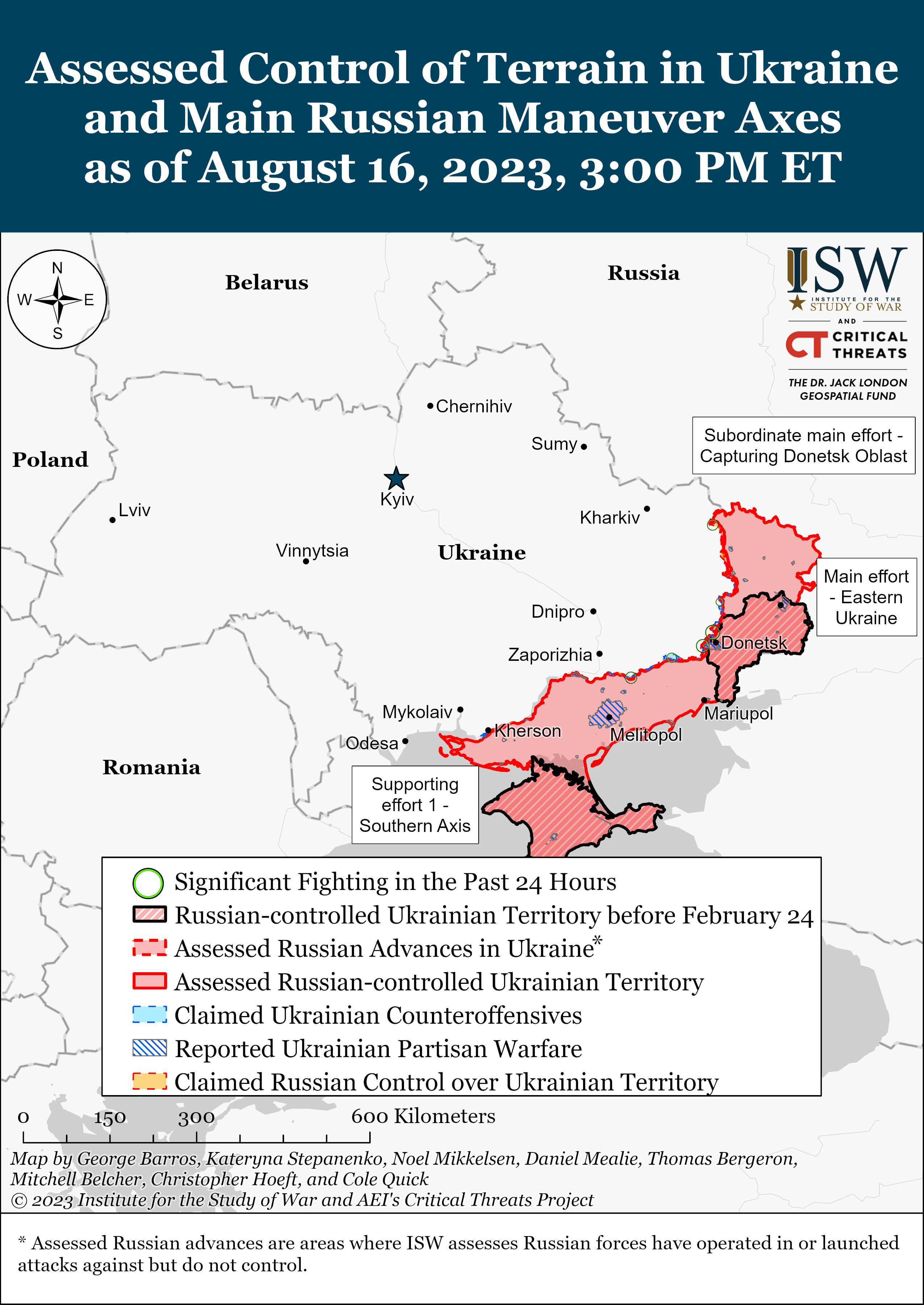
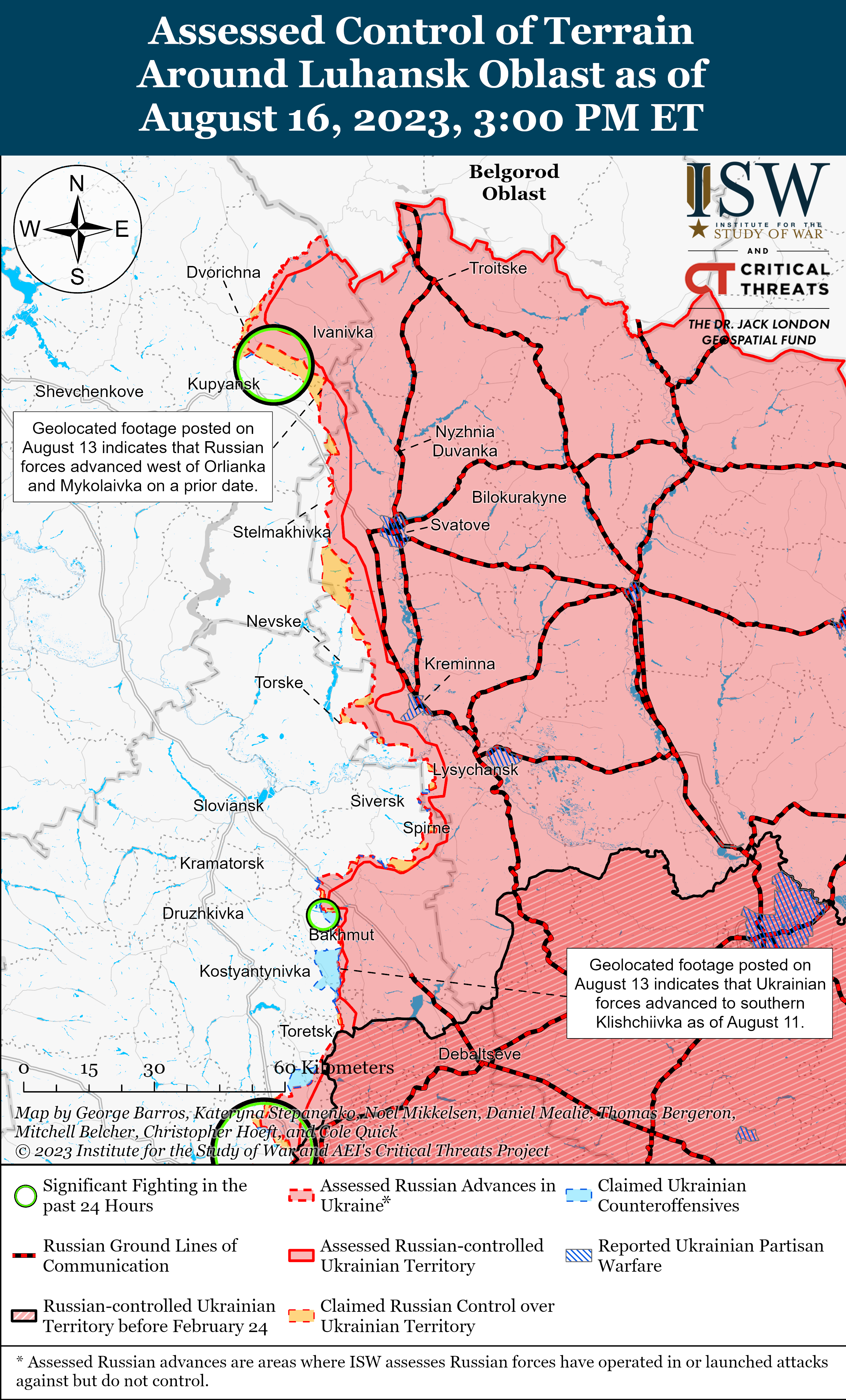
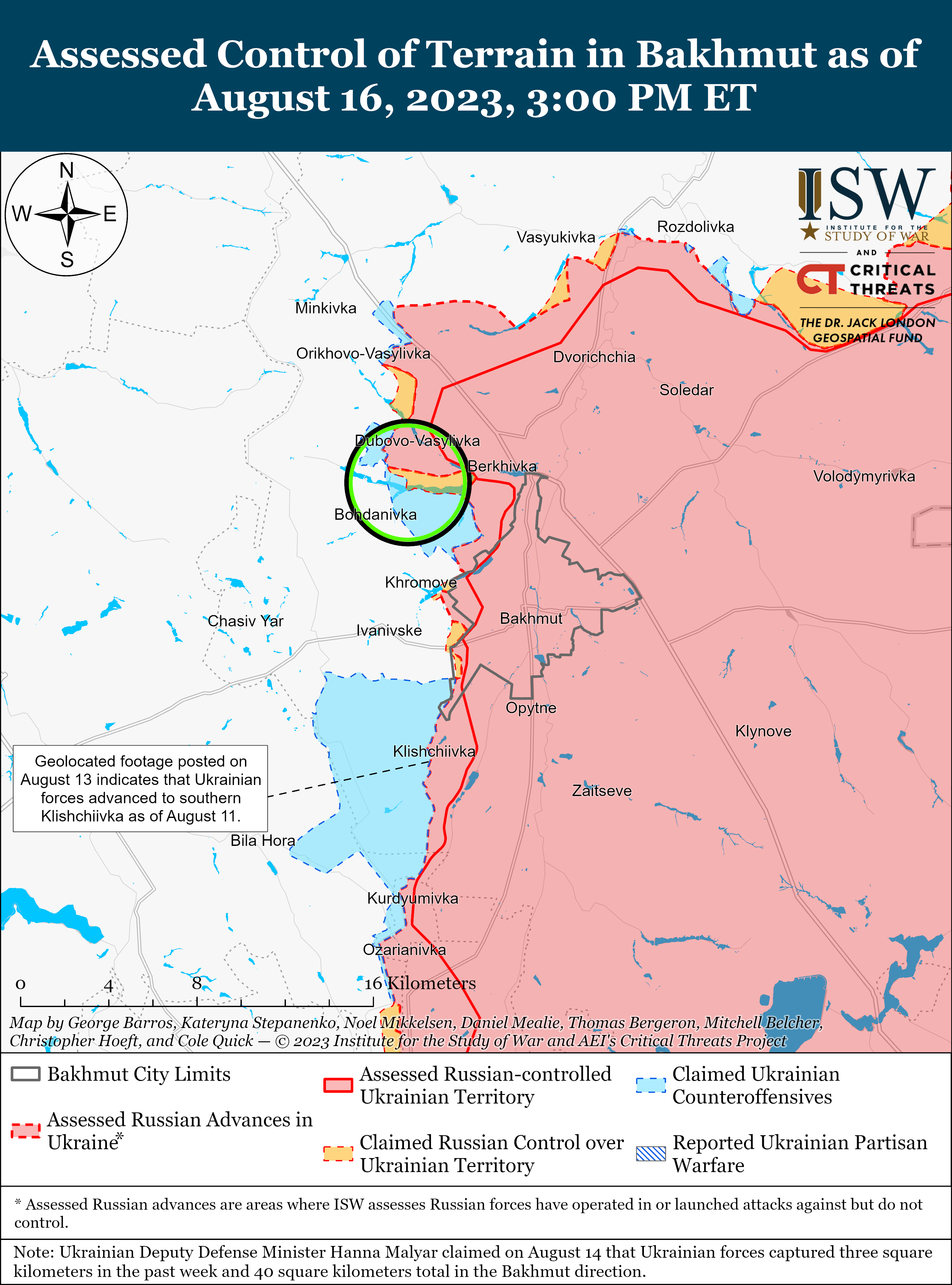
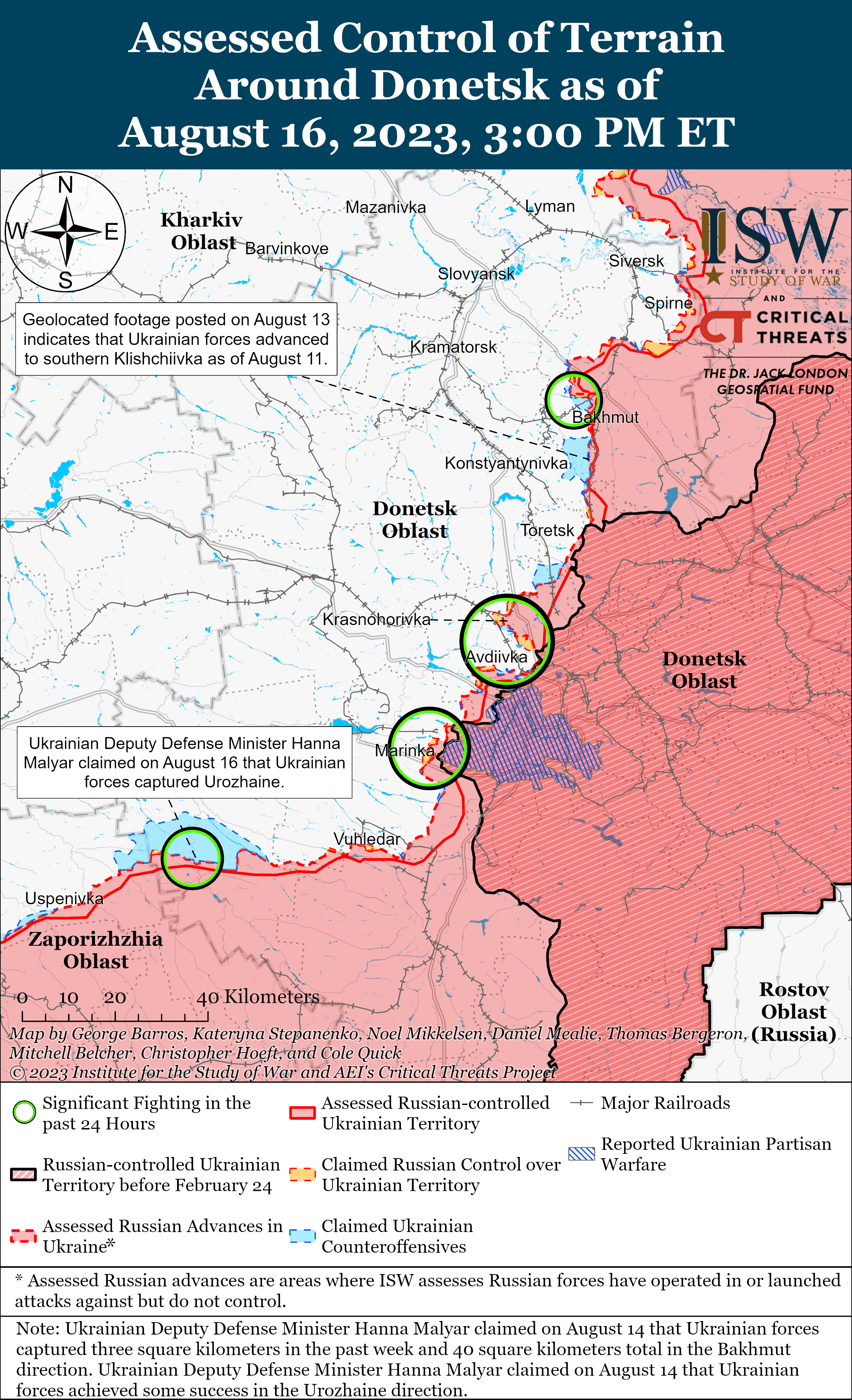
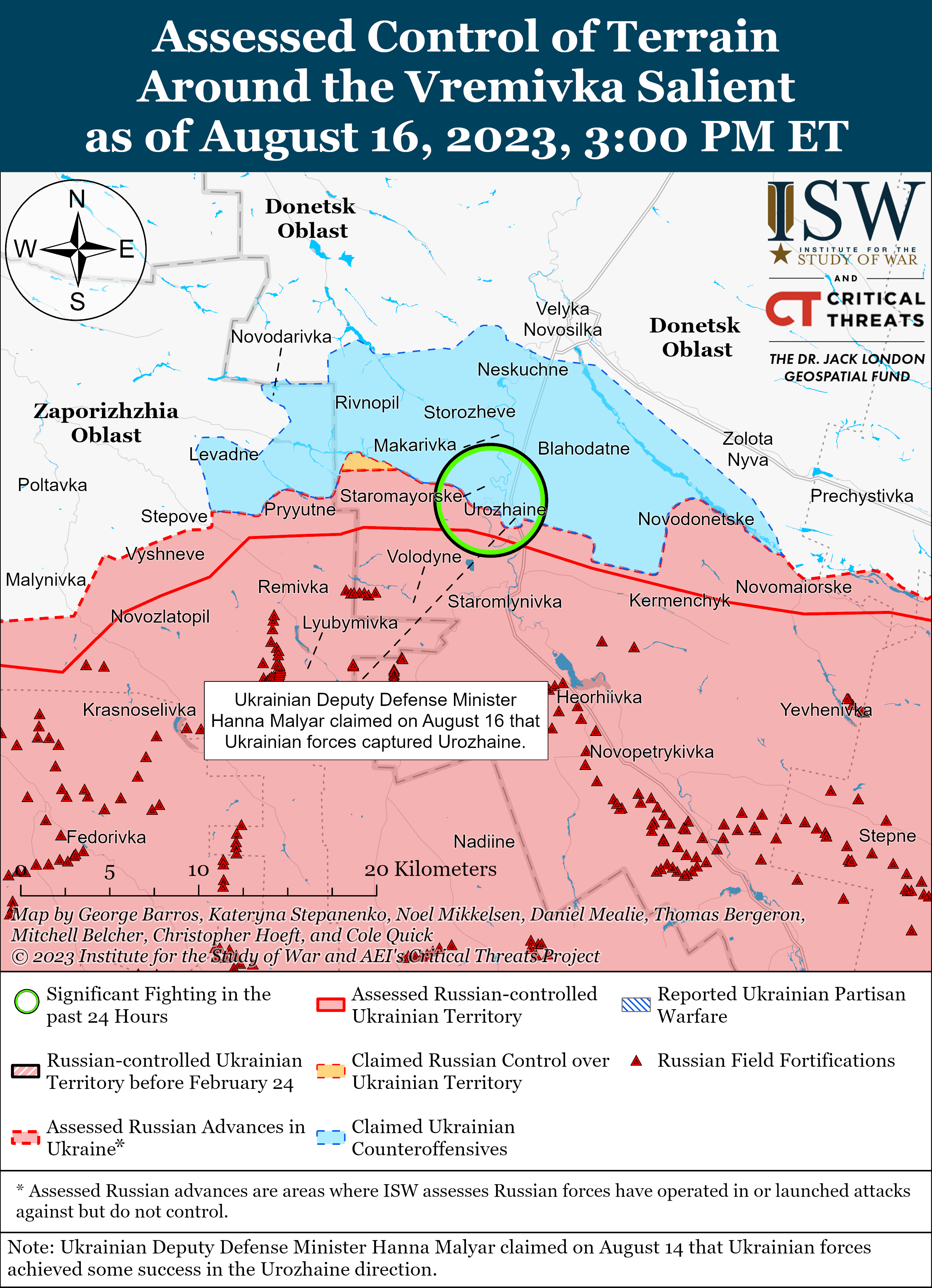
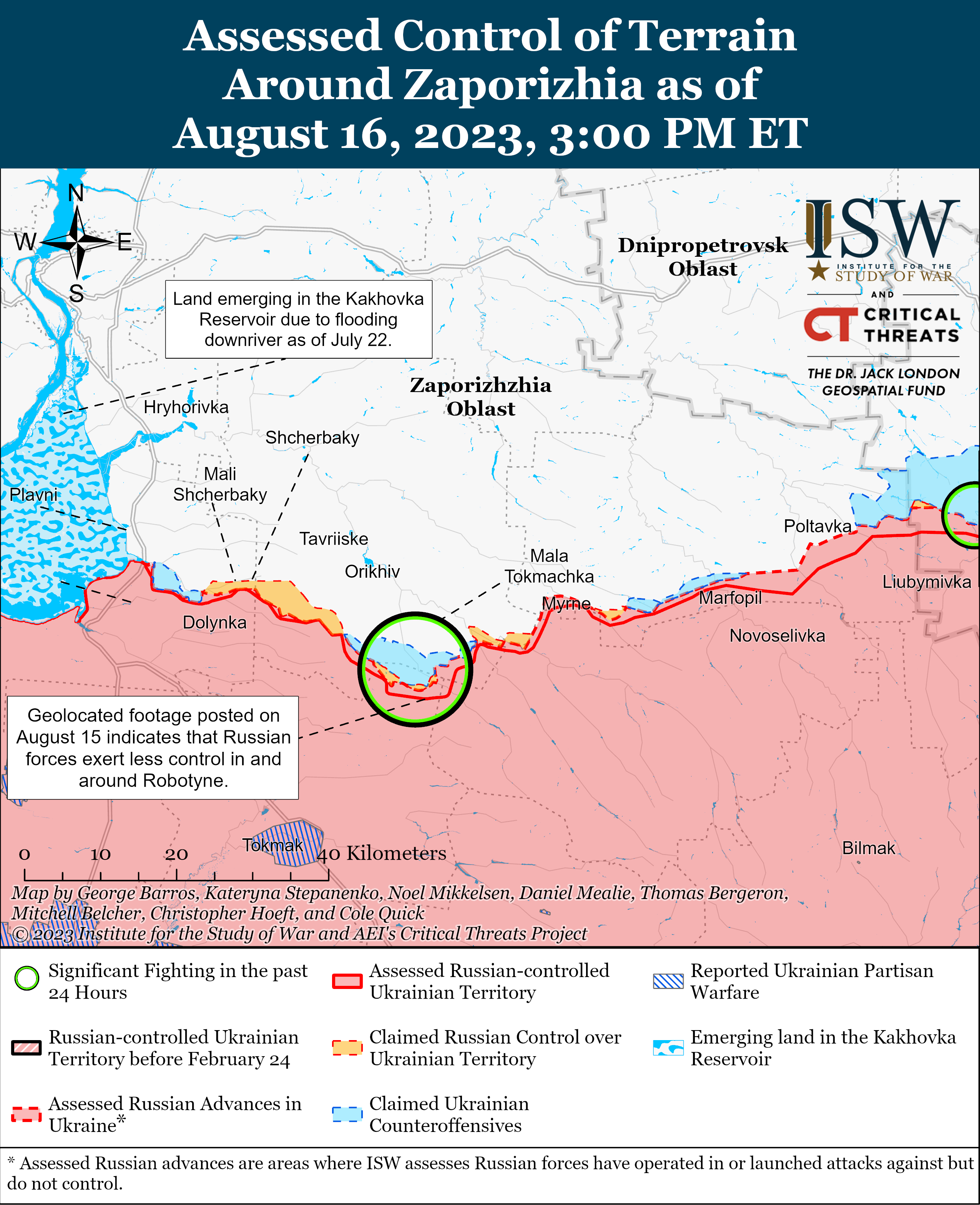
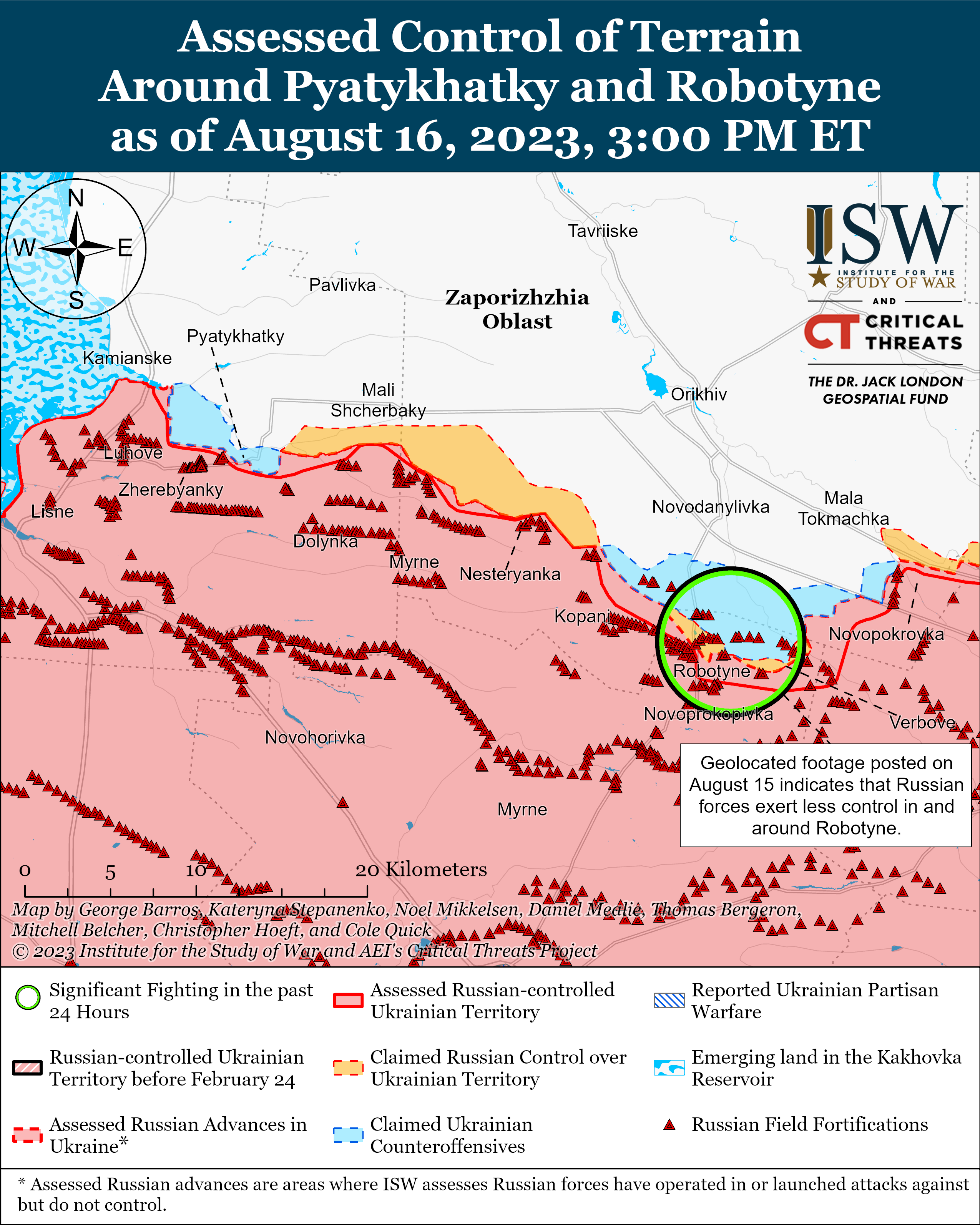
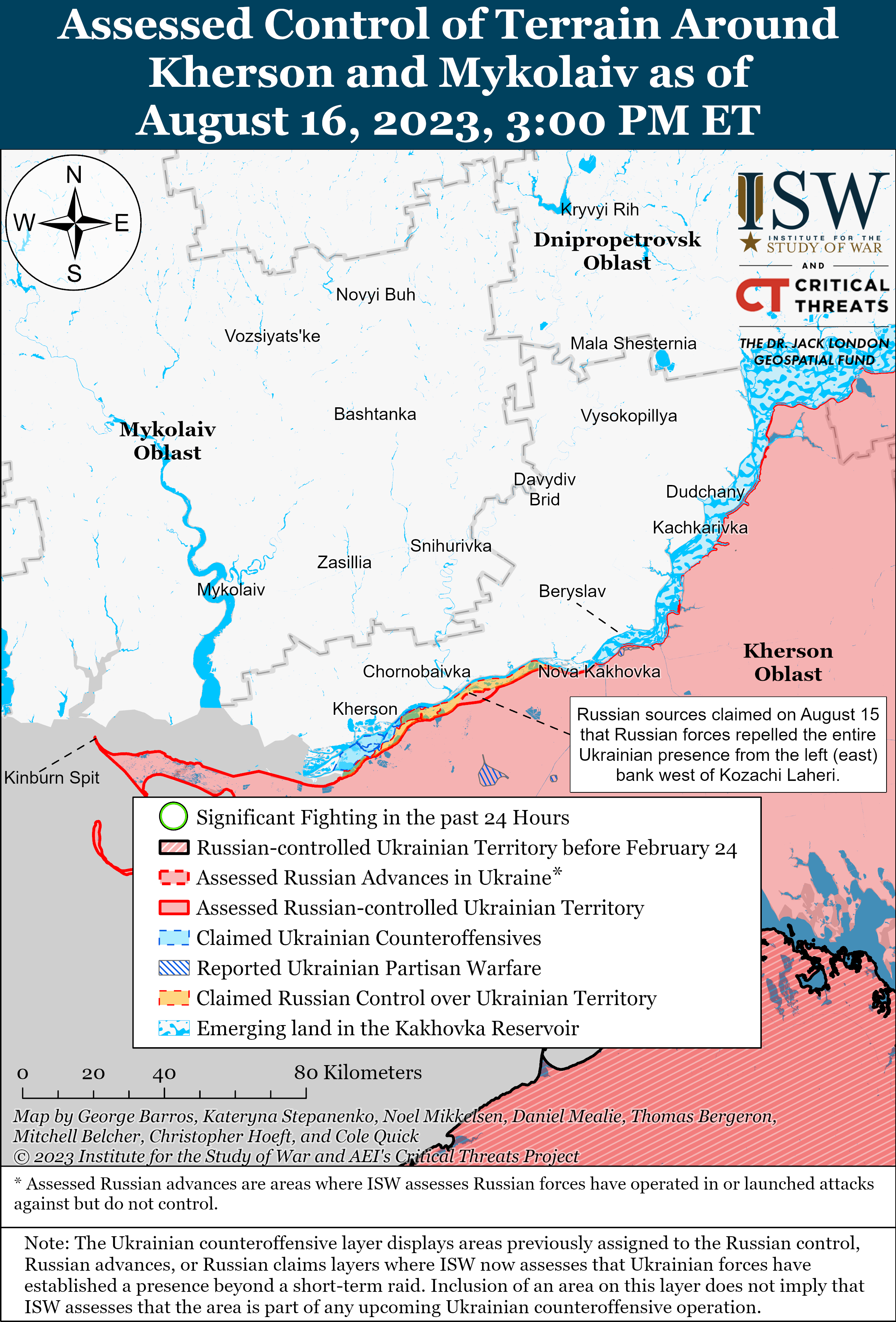
No comments:
Post a Comment